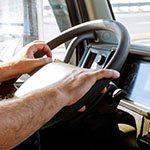Prevent skids and avoid hydroplaning
There are many ways to lose control of a vehicle. Drivers can avoid skids and hydroplaning if they know what to do when either situation occurs.
Tips to avoid skids
When a vehicle skids, it is out of control. As a driver, you can prevent most skids which is easier than correcting one.
As the most major cause of skids is a sudden change in speed and/or direction, you must always be aware of the road surface and adjust your speed accordingly.
Follow these skid-prevention tips to help keep people and property safe:
- Slow down at curves and on slippery surfaces.
- Drive within your sight distance and maintain adequate following distance.
- Adjust your speed to the surface conditions and curvatures of the road.
- Use the brake-limiting valve correctly. Do not over-brake.
- Do not suddenly downshift.
- Inspect the air system and brake adjustment before and during each trip. All wheels should start stopping at the same time. Also inspect your tires, front wheel alignment and the suspension system.
- Load cargo properly.
If you find yourself in a skid despite your best prevention efforts, almost all tractor skids are corrected by the same general responses:
- Disengage the clutch
- Counter steer
- Vehicles with antilock brakes, the driver should apply the brake fully and hold the brake on until they gain control. If you are driving an older vehicle that is not equipped with antilock brakes, stab or pump the brakes to keep them from locking up.
Avoid hydroplaning
Wet, slippery roads can be hazardous for drivers. A change in speed or quick turn can cause a skid. As rain begins to fall, road surfaces are the most slippery because rainwater mixes with oils that coat the surface of the road. Until the oil is washed off the surface, the accumulating water creates a driving hazard called hydroplaning.
Follow these tips to prevent hydroplaning:
- Inspect tires regularly to ensure good working condition. Tire grooves work to move water off the road surface. If tire grooves are not at an adequate depth, they cannot carry water away.
- Make sure tires are adequately inflated. Hydroplaning is more likely to occur when tire pressure is low.
- Reduce your speed to allow for more space behind other vehicles and to allow for more time to stop.
If your vehicle starts to hydroplane, do not panic. Do not use your brake if you are hydroplaning. To regain control of the vehicle, first release the accelerator. Next, push the clutch pedal and allow the wheels to turn freely. As the vehicle slows down, you regain control of it.
References
Federal Motor Carrier Safety Administration, CMV Driving Tips – Too fast for Conditions

 >
>

 >
>
 >
>